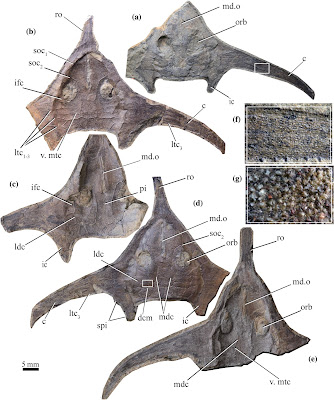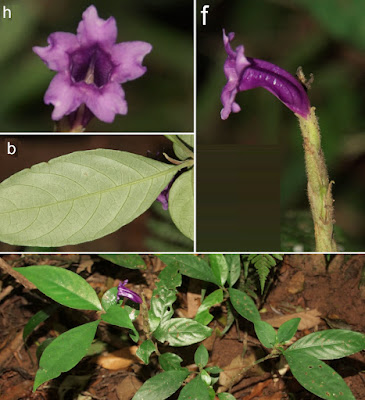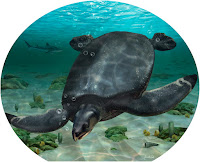[Most Recent Entries] [Calendar View]
Friday, November 18th, 2022
| Time | Event | ||||
| 3:28a | [Paleontology • 2022] Mieridduryn bonniae • Ordovician Opabiniid-like Animals and the Role of the Proboscis in Euarthropod Head Evolution
Abstract A crucial step in the evolution of Euarthropoda (chelicerates, myriapods, pancrustaceans) was the transition between fossil groups that possessed frontal appendages innervated by the first segment of the brain (protocerebrum), and living groups with a protocerebral labrum and paired appendages innervated by the second brain segment (deutocerebrum). Appendage homologies between the groups are controversial. Here we describe two specimens of opabiniid-like euarthropods, each bearing an anterior proboscis (a fused protocerebral appendage), from the Middle Ordovician Castle Bank Biota, Wales, UK. Phylogenetic analyses support a paraphyletic grade of stem-group euarthropods with fused protocerebral appendages and a posterior-facing mouth, as in the iconic Cambrian panarthropod Opabinia. These results suggest that the labrum may have reduced from an already-fused proboscis, rather than a pair of arthropodized appendages. If some shared features between the Castle Bank specimens and radiodonts are considered convergent rather than homologous, phylogenetic analyses retrieve them as opabiniids, substantially extending the geographic and temporal range of Opabiniidae.
Systematic palaeontology Superphylum PANARTHROPODA Nielsen, 199538 Genus Mieridduryn nov. Etymology: From Welsh mieri (bramble) and duryn (proboscis, snout), meaning “bramble-snout”. The dd is pronounced as a soft th, and results from mutation following a feminine noun. Gender f. Diagnosis: Panarthropod with head region bearing dorsal sclerite, annulated proboscis with spiniform dorsal projections and radial mouthparts composed of small, sclerotized plates; gut trace leading to posterior-facing mouth; trunk bears large subrectangular dorsolateral flaps with rounded distal margins; dorsolateral flaps bear setal structures on surface facing body midline; annulated lobopods display triangular outline and possess short triangular spines on posterior margin. Mieridduryn bonniae nov. gen. et sp. Etymology: After Bonnie Douel, niece of the site owners and fossil devotee; the family has followed and supported the research extensively since the discovery of the fauna. Holotype: NMW.2021.3 G.7 known from part and counterpart. Counterpart preserves anterior portion only. Locality and horizon: Collected from the Darriwilian (Middle Ordovician, Didymograptus murchisoni Biozone) Gilwern Volcanic Formation at Castle Bank, near Llandrindod, Powys (UK) Material, locality, and horizon: NMW.2021.3 G.8, known from part and counterpart. Collected from the Darriwilian (Middle Ordovician, Didymograptus murchisoni Biozone) Gilwern Volcanic Formation at Castle Bank, near Llandrindod, Powys (UK) Stephen Pates, Joseph P. Botting, Lucy A. Muir and Joanna M. Wolfe. 2022. Ordovician Opabiniid-like Animals and the Role of the Proboscis in Euarthropod Head Evolution. Nature Communications. 13: 6969. DOI: 10.1038/s41467-022-34204-w | ||||
| 6:48a | [PaleoIchthyology • 2022] New Data on the Cranial Anatomy of Pterogonaspis (Galeaspida: Tridensaspidae) from the lower Devonian of Yunnan, China and its Evolutionary Implications
Abstract New material of the tridensaspid Pterogonaspis yuhaii is described from the Xujiachong Formation in Qujing City, Yunnan Province, revealing the morphology of the ventral side of the headshield for the first time. Most significantly, the cranial anatomy of Pterogonaspis provides the first fossil evidence for the position of the esophagus in galeaspids. The esophagus and dorsal aortae display a central placement in the postbranchial region and do not share a common canal as in osteostracans. Moreover, the paired and symmetrically extending dorsal aortae in galeaspids strikingly resemble those of jawed vertebrates, probably representing a plesiomorphic condition for vertebrates because they are also present in amphioxus and hagfishes. In contrast, the unpaired and asymmetrically extending dorsal aorta in osteostracans is similar to that of lampreys, probably resulting from convergent evolution. In addition, our new data also exhibit some characters that galeaspids uniquely share with osteostracans, such as the complete endoskeletal postbranchial wall and the extensive lateral expansion of the headshield with the marginal arteries and veins. Keywords: dorsal aorta, esophagus, Pterogonaspis, Qujing, Yunnan SYSTEMATIC PALEONTOLOGY Subclass Galeaspida Tarlo, 1967. Order Eugaleaspiformes (Liu, 1965; Liu, 1980). Family Tridensaspidae (Liu, 1986). Genus Pterogonaspis (Zhu, 1992). Pterogonaspis yuhaii (Zhu, 1992) Diagnosis (emended): The margin between the cornual process and the inner cornual process serrated; median dorsal opening fissure-shaped with length/width ≈ 10, calabash-shaped oralobranchial fenestra, six pairs of branchial fossae; ornamentation composed of minute granular tubercles, about 16 tubercles/mm2. Locality and Horizon: Xujiachong Village, Qilin District, Qujing City, Yunnan Province, Xujiachong Formation, Cuifengshan Group, Pragian, Early Devonian. Xin-Yuan Meng, Min Zhu, Qiang Li and Zhi-Kun Gai. 2022. New Data on the Cranial Anatomy of Pterogonaspis (Tridensaspidae, Galeaspida) from the lower Devonian of Yunnan, China and its Evolutionary Implications. The Anatomical Record. DOI: 10.1002/ar.25098 | ||||
| 7:38a | [Botany • 2021] Strobilanthes bolavenensis (Acanthaceae) • A New Species from Bolaven Plateau, southern Laos
Abstract A new species of Strobilanthes (Acanthaceae), S. bolavenensis, is described from Bolaven Plateau, southern Laos. Photos and illustration are given together with information of habitat, ecology, vernacular name and preliminary conservation assessment based on IUCN criteria. Keywords: Flora of Laos, Indochina, Lamiales, Lao PDR, taxonomy Strobilanthes bolavenensis K. Yamaz., Tagane & Soulad., sp. nov. Type:—LAOS. Champasak Province, Dong Hua Sao National Protected Area [Bolaven Plateau], Paksong District, ___ in lower montane forest, 15°__′__″N, 106°__′__″E, 1167 m, 18 December 2019, Souladeth P., Tagane S., Kongxaysavath D., Rueangruea S., Somran S., Suyama Y., Suzuki E. L3452 [fl. & young fr.] (holotype FOF!, isotype: KAG [KAG155816!]). Strobilanthes bolavenensis is most similar to S. guangxiensis endemic to Guangxi, China in having purple corolla and hairy simple spike inflorescence but distinguished by its smaller plant height up to 30 cm tall (vs. ca. 1 m tall), rachis of inflorescence sparsely puberulent (vs. densely pubescent), bracts and bracteoles covered with short appressed yellowish brown hairs near apex adaxially (vs. glabrous), larger calyx length 1.4–1.6 cm long (vs. 1 cm long), and calyx acute at apex (vs. acuminate). Distribution and habitat:— LAOS, known only from the type locality. Strobilanthes bolavenensis was found in hill evergreen forests at 1167 m elevation, where it grows with Hymenasplenium excisum (C. Presl) S. Linds. (Aspleniaceae), Cornopteris opaca (D. Don) Tagawa (Athyriaceae), Cyclosorus ciliatus (Wall. ex Benth.) Panigrahi (Thelypteridaceae), Canscora andrographioides Griff. ex C. B. Clarke (Gesneriaceae), Sonerila yunnanensis Jeffrey ex W. W. Sm. (Melastomataceae). Etymology:— This specific epithet “bolavenensis” refers to the type locality of this species. Vernacular name:— Hom Bolaven [ຫ້ອມບໍລະເວນ]. Kaito Yamazaki, Phetlasy Souladeth and Shuichiro Tagane. 2021. Strobilanthes bolavenensis, A New Species of Acanthaceae from Bolaven Plateau, southern Laos. Phytotaxa. 513(2); 152-158. DOI: 10.11646/phytotaxa.513.2.6 | ||||
| 2:32p | [Paleontology • 2022] Leviathanochelys aenigmatica • A Gigantic Bizarre Marine Turtle (Testudines: Chelonioidea) from the Middle Campanian (Late Cretaceous) of South-western Europe
Abstract Marine turtles were common in the subtropical Upper Cretaceous epi-continental seas that once washed the coasts of the ancient European archipelago. But unlike its contemporaneous faunas from North America, in Europe no taxon surpassed the 1.5 m shell-length. Here, the remains of a new large marine turtle, Leviathanochelys aenigmatica gen. et sp. nov., from the Middle Campanian of the Southern Pyrenees are described. Anatomical and histological evidence concur in identifying the specimen as a basal chelonioid. The new taxon autapomorphically differs from other marine turtles by possessing an additional process on the anteromedial side of the pelvis, and an acetabulum directed strongly ventrally. Based on the pelvis size, it is likely that Leviathanochelys was as large as Archelon, thus becoming one of the largest marine turtles found to ever exist. The large body size of the new taxon could have evolved as a response to the unique habitat conditions of the European Cretaceous archipelago seas. The presence of the accessory pubic process further suggests the occurrence of an additional insertion point of the Musculus rectus abdominis, which together with the paleohistologic evidences support the hypothesis that the new taxon had an open marine pelagic lifestyle. Systematic palaeontology Testudines Batsch, 1788. Cryptodira Cope, 1868. Chelonioidea Baur, 1893. Leviathanochelys aenigmatica gen. et sp. nov. Etymology: The generic name is composed of the following words: Leviathan, in reference to the Biblical marine beast, in allusion to the body size of the new species; and chelys, Latinized name from the ancient Greek χέλυς (“khélūs” meaning turtle in feminine gender). The specific nomination aenigmatica, Latinized adjective from the Greek noun αἴνιγμα (“aínigma” meaning enigma, conundrum or riddle) is in reference to the peculiar anatomical characteristics of its pelvis and carapace. Type locality and age: Cal Torrades, Coll de Nargó (Lleida Province, Catalonia, North-eastern Spain). Lower part of the Perles Formation, Middle Campanian, Upper Cretaceous. Diagnosis: Large-sized basal chelonioid defined by the following and unique combination of characters: reduction of the costal plates ossification without a sutural contact between costals and peripherals; carapacial plate margins (costals 5–8 and neurals 5–8) finely sutured; hexagonal/octagonal neural plates, longer than wide, that prevent the costals 6–7 from contacting one another; posterior costal plates that are rectangular-shaped, much wider than long; oval articular area of the ilium, located near the lateral margin of the right costal 8; H-shaped pelvis; enlarged and flat lateral pubic process; conspicuously ornamented, textured surface surrounding the acetabular region; extremely elongated iliac neck; and the absence of carapacial scute sulci, keels, or ornamentation on the external part of the carapace, and absence of the ilium’s posterior notch. Leviathanochelys aenigmatica is further diagnosed by having two autapomorphic characters as follows: accessory process on the anteromedial margin of the pubis; and acetabulum strongly ventrolaterally directed. Oscar Castillo-Visa, Àngel H. Luján, Àngel Galobart and Albert Sellés. 2022. A Gigantic Bizarre Marine Turtle (Testudines: Chelonioidea) from the Middle Campanian (Late Cretaceous) of South-western Europe. Scientific Reports. 12: 18322. DOI: 10.1038/s41598-022-22619-w https://phys.org/news/2022-11-fossil-lar |
| << Previous Day |
2022/11/18 [Calendar] |
Next Day >> |



















